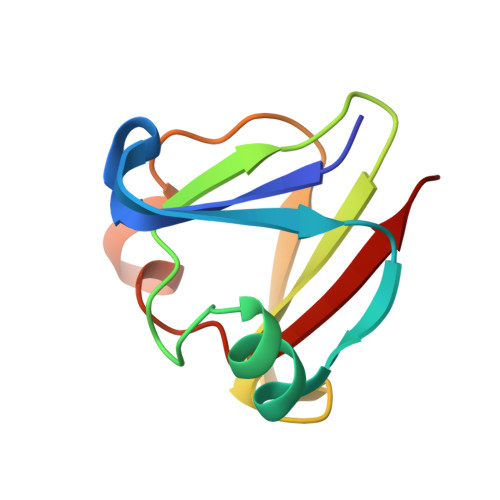betagamma-Crystallin superfamily contains a universal motif for binding calcium.
Aravind, P., Mishra, A., Suman, S.K., Jobby, M.K., Sankaranarayanan, R., Sharma, Y.(2009) Biochemistry
- PubMed: 19921810
- DOI: https://doi.org/10.1021/bi9017076
- Primary Citation of Related Structures:
3HZ2, 3HZB, 3I9H, 3IAJ - PubMed Abstract:
The betagamma-crystallin superfamily consists of evolutionarily related proteins with domain topology similar to lens beta- and gamma-crystallins, formed from duplicated Greek key motifs. Ca(2+) binding was found in a few betagamma-crystallin members earlier, although its prevalence and diversity as inherent molecular properties among members of the superfamily are not well studied. To increase our understanding of Ca(2+) binding in various betagamma-crystallins, we undertook comprehensive structural and Ca(2+)-binding studies of seven members of the superfamily from bacteria, archaea, and vertebrates, including determination of high-resolution crystal structures of three proteins. Our structural observations show that the determinants of Ca(2+) coordination remain conserved in the form of an N/D-N/D-#-I-S/T-S motif in all domains. However, binding of Ca(2+) elicits varied physicochemical responses, ranging from passive sequestration to active stabilization. The motif in this superfamily is modified in some members like lens crystallins where Ca(2+)-binding abilities are partly or completely compromised. We show that reduction or loss of Ca(2+) binding in members of the superfamily, particularly in vertebrates, is due to the selective presence of unfavorable amino acids (largely Arg) at key Ca(2+)-ligation positions and that engineering of the canonical Ca(2+)-binding residues can confer binding activity on an otherwise inactive domain. Through this work, we demonstrate that betagamma-crystallins with the N/D-N/D-#-I-S/T-S motif form an extensive set of Ca(2+)-binding proteins prevalent in all of the three kingdoms of life.
- Centre for Cellular and Molecular Biology, Council of Scientific and Industrial Research, Uppal Road, Hyderabad 500007, India.
Organizational Affiliation:

















